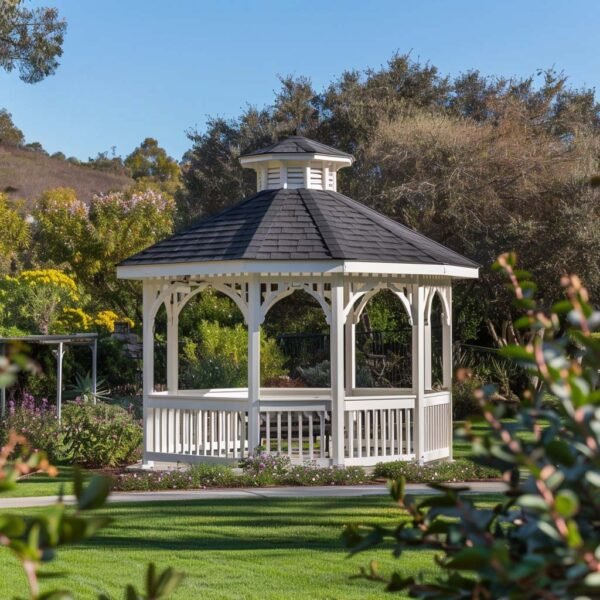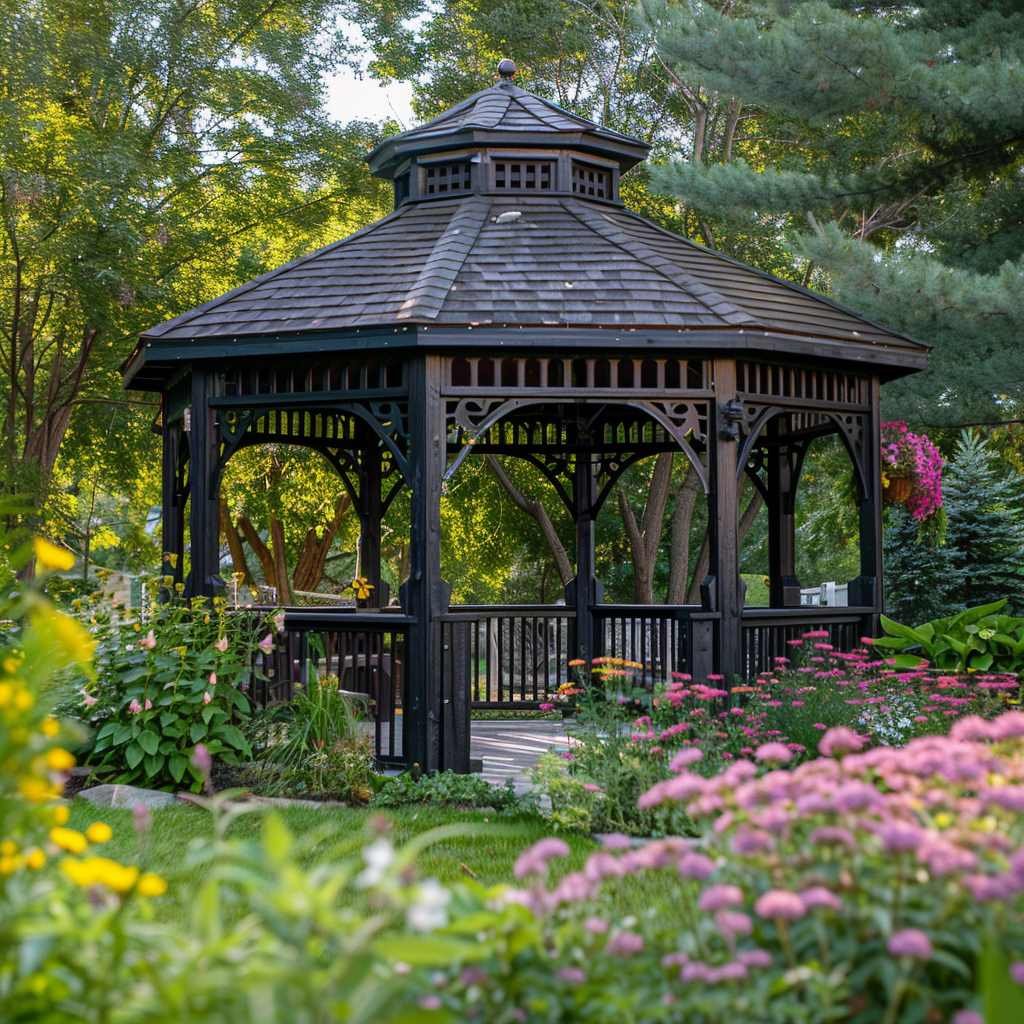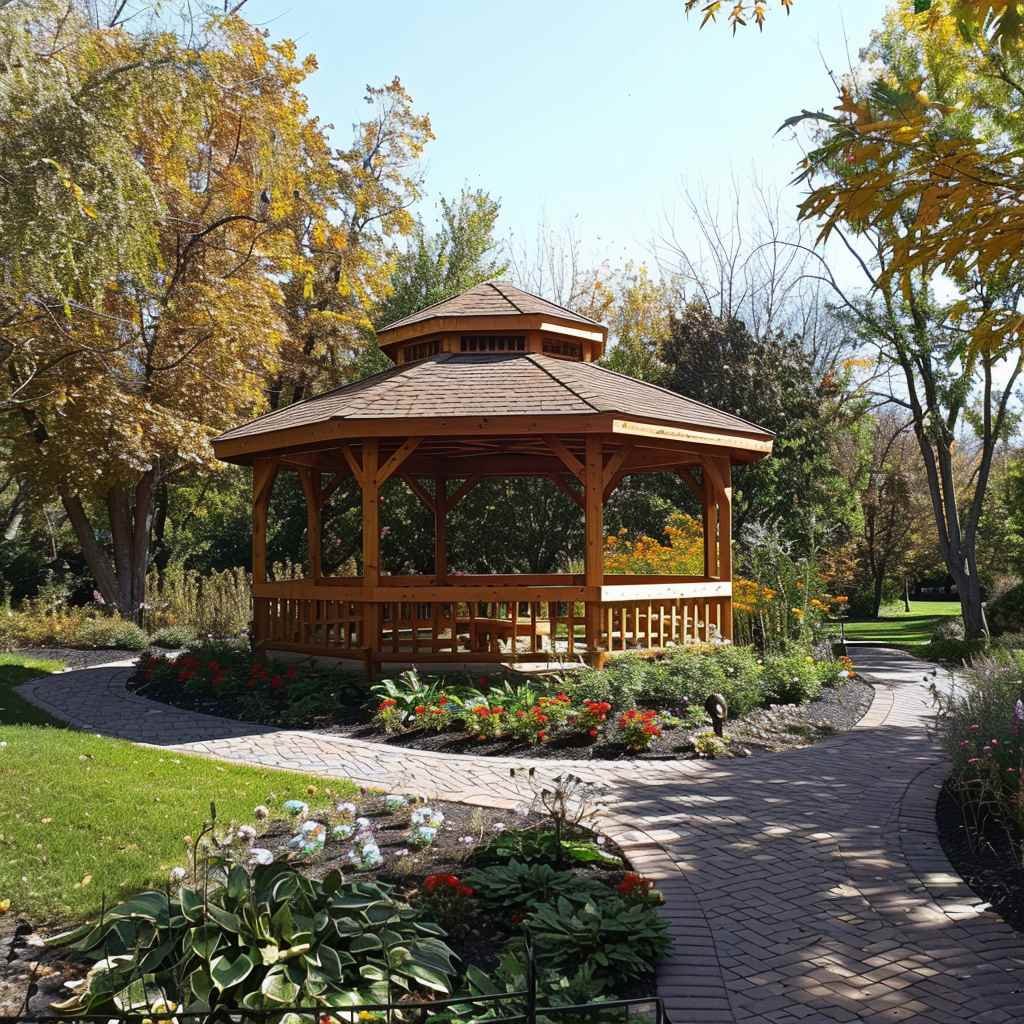A gazebo creates a charming and functional space right in your backyard, offering a place to relax, entertain guests, or simply enjoy some quiet time.
Gazebo installation isn’t just about adding a structure; it’s about creating a space that enriches your lifestyle.
Key Takeaways
- Gazebos enhance backyard aesthetics and functionality.
- They provide shelter and a versatile space for various activities.
- Multiple design and material options are available to suit different needs.
Benefits of Gazebo Installation

Installing a gazebo provides several advantages. It can enhance the beauty of your yard, increase your property’s value, and create an additional space for various activities.
Enhanced Outdoor Aesthetics
A gazebo adds a touch of elegance to your backyard. Gazebos come in various designs, materials, and sizes, allowing you to choose one that complements your home’s architecture.
Gazebos can also be decorated to fit the seasons or special events. Adding lighting, plants, or curtains can make your gazebo the highlight of your backyard.
Increased Property Value
A well-installed gazebo can boost your home’s market value. Potential buyers often look for unique features that set a property apart, and a gazebo does just that.
Gazebos indicate that you have invested in the maintenance and beautification of your property. This can make your home more attractive to buyers, helping it sell faster and at a better price.
Extended Living Space
Adding a gazebo extends your living area to the outdoors. It creates a sheltered spot where you can enjoy fresh air regardless of the weather.
This extra space can be particularly useful for families. Children can play outside under the protection of the gazebo, and adults can enjoy gatherings without worrying about the sun or rain.
Gazebo Design and Material Options

Choosing the right design and materials for your gazebo can be the key to creating a beautiful and functional addition to your outdoor space.
Wooden Charm Versus Metal Modernity
Wooden Gazebos offer a classic, elegant look.
Popular wood choices include cedar, redwood, and pine.
Cedar is valued for its natural resistance to decay, insects, and rot due to its natural resins.
Redwood and pine can be treated for durability and weather resistance.
Metal Gazebos are often made from aluminum or steel.
Aluminum is light, rust-resistant, and requires minimal maintenance.
Steel gazebos tend to be sturdier and more durable, though they might need more care to prevent rust.
Customizable Features for Personalization
Roof Styles
Gazebo roofs come in various shapes, including octagonal, square, and rectangular. You can also choose between hardtops made from metal or wood, and soft tops crafted from durable fabrics.
Integrated Seating and Features
Consider built-in benches, swings, or outdoor kitchens. Benches around the perimeter can add more seating without taking up extra space. Swings add a playful touch and are perfect for relaxation.
Decorative Elements
Incorporate latticework, curtains, or lighting. Latticework can provide added privacy and support climbing plants for a green touch. Lighting, such as string lights or lanterns, extends the usability of your gazebo into the evening, creating a charming ambiance.
Practical Uses of Gazebos
Gazebos offer versatile benefits by serving as an entertainment hub for social events and providing a space for relaxation and wellness.
Entertainment Hub for Social Events
Gazebos make an excellent focal point for social gatherings. They provide a sheltered area for hosting parties, barbecues, or family dinners. The roof offers protection from sudden weather changes, making sure your event continues uninterrupted.
For evening gatherings, you can add lighting fixtures to create a cozy atmosphere. Set up some comfortable seating and perhaps a table for dining.
Relaxation and Wellness Space
A gazebo can also serve as your personal retreat. Equipped with lounge chairs, it becomes the perfect spot for reading a book or sipping morning coffee while enjoying nature’s beauty.
Consider installing a small fountain or some potted plants to enhance the serene atmosphere, for a relaxing area to read books and enjoy some shade.
Installation Considerations

When planning to install a gazebo, site preparation and permit requirements are essential for a successful project. These ensure your gazebo is safe, strong, and compliant with local regulations.
Site Preparation and Location
Choosing the right spot in your backyard is crucial. The ground where your gazebo will sit must be level to prevent any structural instability.
Start by clearing any debris, rocks, or plants from the area. The foundation can be built from various materials such as pavers, concrete, or decking.
Considerations:
- Make sure the area is accessible to the house and other outdoor features.
- Check the proximity to trees for added shade and shelter.
- Avoid areas with poor drainage to prevent water damage.
Permit Requirements and Regulations
Before starting your gazebo project, check with your local building authority. Many areas require permits for new structures. Permits ensure that your gazebo meets all safety and zoning codes. Failure to obtain necessary permits can lead to fines or even removal of the structure.
Steps:
- Contact your local municipality.
- Submit plans detailing the size and placement of your gazebo.
- Await approval before beginning installation.
Also, check for any homeowner association (HOA) rules that may apply to your property. Some neighborhoods have specific guidelines about outdoor structures, including color, size, and height limits.
